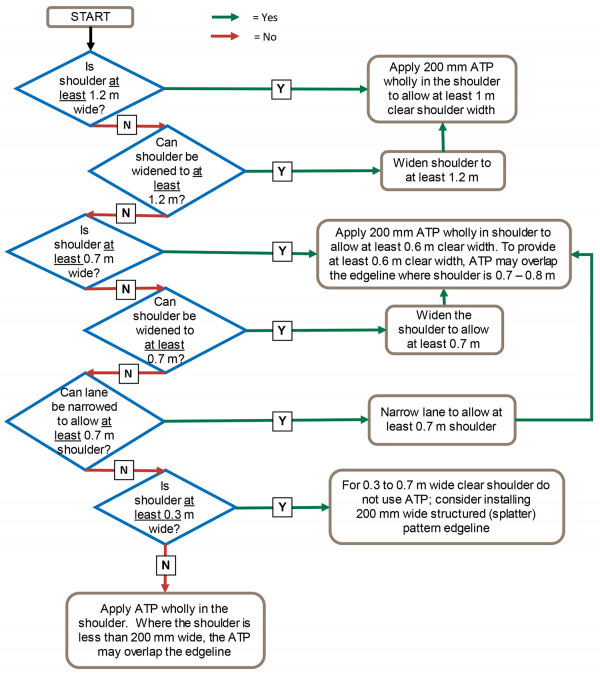Edgelines
Refer to edge treatments-edgelines for standard edgeline marking details.
Edge treatments - Edgelines
ATP edgeline markings are used to supplement standard edgeline markings on sections of rural road where:
- traffic volumes are over 1000vpd; or
- there is a significant safety risk; or
- there are specific site problems such as poor visibility, frequent heavy rain fall, a night-time crash history; and
- provision for cyclists is considered (see cyclists);
Cyclists
and
- noise disturbance to sensitive land uses is unlikely (see noise).
Noise
ATP used to alert errant road users they are deviating from their lane is most effective where those road users have shoulder width available beyond the ATP on which to recover their vehicle and return to the lane.
For guidance on the decision-making process for the application of ATP edgeline markings when considering cyclists, refer to Figure 2‑15 and Figure 2-16.
Figure 2-15: ATP decision making flowchart when considering cyclists

View larger image [JPG, 618 KB]
Figure 2-15 notes:
- Cyclists should be expected to be present on all roads that they are legally allowed to use, therefore, consideration should always be given for their safety when installing ATP. Cyclists will tend to avoid ATP because riding along or crossing it can destabilise or damage cycles which may result in crashes.
- In all cases it is desirable to provide a shoulder of at least 1000mm for cyclists to use. However, a shoulder width of at least 600mm can accommodate most cyclists and will not usually prevent the installation of ATP.
- Where a shoulder is less than 300mm wide, cyclists will generally cycle in the traffic lane to avoid surface defects at the edge of seal and the reduced friction that may be present on edgeline markings. Therefore, ATP should be marked in the shoulder.
- Where shoulder width is between 300mm and 600mm, cyclists are likely to use both the shoulder and the lane and may cross the edgeline frequently, therefore ATP should not be installed unless the shoulder width can be increased to safely accommodate cycling.
- Where shoulder width varies, designers should endeavour to have a consistent shoulder width constructed but if this cannot be achieved, the ATP installation (as appropriate) should be consistently installed along the section. However, the shoulder width should not be averaged over the length to determine the most appropriate configuration for the ATP.
Lane lines
Where audio tactile profiled (ATP) markings are installed on lane lines, refer to the standard lane lines section for standard lane line marking details.
Standard lane lines